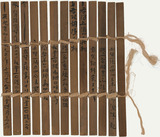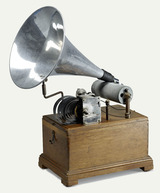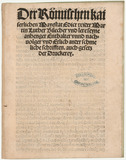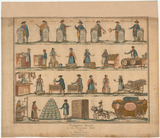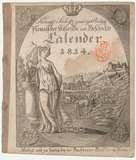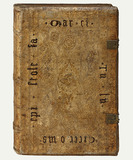Chinese book made of bamboo
Early book form from China, circa 93 CEThe handwritten weapons directory stands out because of its form, which is unusual in our writing culture. It consists of 13 narrow bamboo sticks with letters written on them and tied together with two pieces of string.
Cylinder phonograph, 1902-1905
Competition for shellac records and the gramophoneThe phonograph (Greek, literally: writer of sounds) is an acoustic, mechanical recording and playback device. The term refers to a speech recording and playback device, the invention of which was made public by Thomas Edison on November 21, 1877.
E-book
A book no matter where you are, early 21st centuryAlthough the first commercially published e-book – William Gibson’s novel Mona Lisa Overdrive – hit the shelves in 1988, this paperless form of literature long languished as a niche interest without widespread recognition. In the pioneering years of the internet, digital texts were mostly exchanged online free of charge and without the permission of authors and publishers.
Edict of Worms
Martin Luther’s writings are condemned, 1521 After Martin Luther refused to retract the ideas of his heretical writings at the Diet of Worms, he was issued with an imperial ban and thus declared an outlaw. The imperial decree of May 8, 1521 forbid the teaching and distribution of his printed works and future writings.
Emil and the Detectives
A children’s book classic by Erich Kästner, 1929Emil Kästner’s children’s book Emil and the Detectives has been one of the most-read German children’s books for decades. The story of Emil Tischbein, a boy from a small town who hunts a thief in 1920s Berlin, has been reprinted countless times since its first publication in 1929 and has been adapted numerous times for the screen, stage and radio and also turned into comic book versions and even board games.
Èpinal print
Explaining the world with pictures, 1811Èpinal prints were extremely popular pictorial and reading media of the 18th and 19th centuries. They combined text and pictures and provided informative, instructive, devotional, and entertaining material as well as news on a sheet of paper.
Farmer's calendar
A guide for everyday life, 1814In this Saxon Calendar, in addition to the calendar itself, which includes saints' days, name days, astrological signs, the movements of the planets, weekly scriptures and weather predictions, there are also free pages for personal notes. The handwritten remarks reveal the owner to be a farmer.
Feyerabend Bible, 1564
Martin Luther’s translation for the first time with uniform illustrationThis lavishly illustrated Bible was considered one of the most beautiful biblical creations of its era thanks to its 140 woodcuts with a uniform colour scheme, as created by Virgil Solis. After the appearance of Luther’s first full German biblical translation in 1534, so-called Luther Bibles began to be printed in different versions and in large numbers.
Geist und Maschine (Soul and Machine)
A film about the Bibliographical Institute in Leipzig, 1926The film Geist und Maschine (Soul and Machine) produced in 1926 by the Döring-Film-Werken in Hannover is regarded as one of the first major attempts by a German publishing house to make use of the (competing) medium of film for advertising purposes. On the occasion of the 100th anniversary of the founding of the publishing house, Richard Brodführer who was at that time an editor at the Bibliographical Institute was commissioned by company management to write a film script for a silent film about the company’s book production unit with a particular focus on the production of Meyers Lexikon.
Gothic book-binding by Johannes Richenbach
A masterpiece of Late Middle Ages book-binding art, after 1478The book binding, made of light-coloured leather with a delicate blind-stamped decoration, was done by the hand of Johannes Richenbach (died 1486), a prominent bookbinder of the 15th century. Stamps of roses and lilies, as well as of the image of Christ and the Agnus Dei decorate the front cover.
